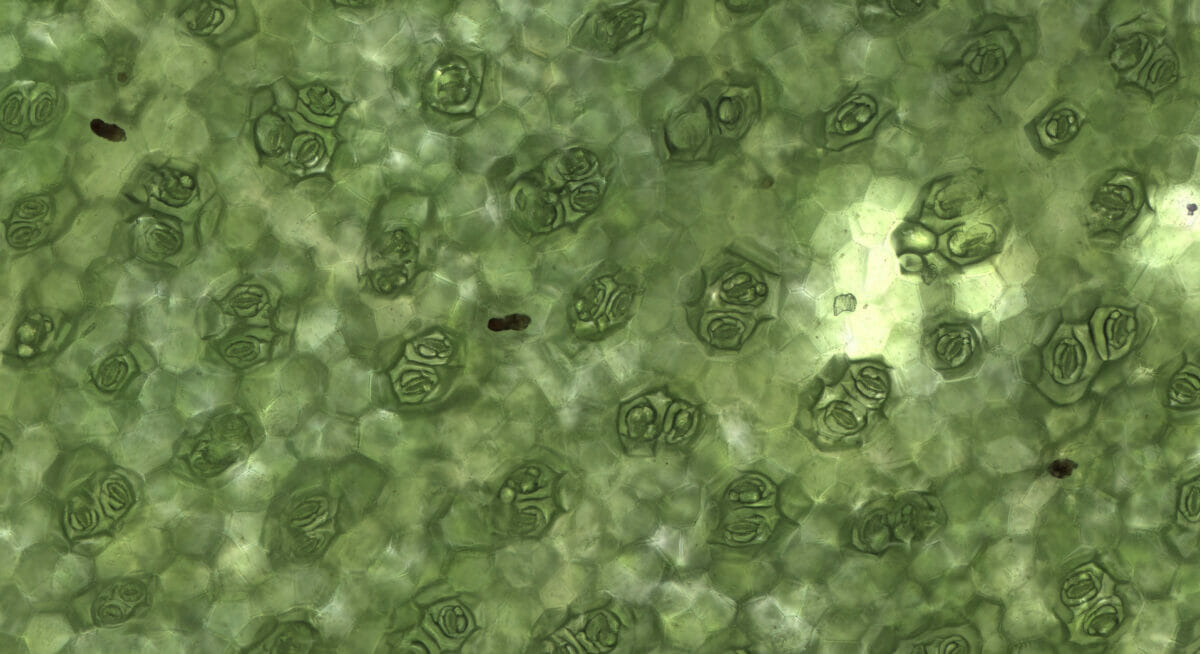Plants Have Mouths–And They Could Help Agriculture Adapt to Climate Change
A rare case where being a voluntary mouth breather is superior.
Plants Have Mouths–And They Could Help Agriculture Adapt to Climate Change
A rare case where being a voluntary mouth breather is superior.

These plant stomata could help feed our growing population.by Douglas Clark
Plants—they have mouths, just like us. Unlike us, however, these plant mouths might actually help us feed the growing population in the face of climate change.
A new study from the University of California San Diego and the U.S. National Science Foundation looked at how these plant mouths, also called the stomata, function. Researchers built upon 20 years of findings from the stomata and its molecular, genetic and mechanical functions around carbon dioxide—the stuff we exhale with each breath. The study found that plants are able to sense carbon dioxide levels in their surroundings, and then control their stomata based on how much CO2 they want to suck up. In a sense, plants can regulate their breathing.

To understand the significance of this finding is to understand the careful balance plants must strike between carbon dioxide intake and water vapor loss—all of which is influenced by how long their stomata stay open. On a basic level, stomata open their central pore to take in carbon dioxide. But as this happens, the inside of the plant is exposed to the elements, causing water to get lost in the surrounding air. If too much water is lost, that’s when plants dry out.
Researchers say their discovery will allow them to modify a plant’s sensors either through gene editing or breeding—in other words, creating crops that can retain water more efficiently when drought hits or CO2 levels increase as the planet heats up.
In this year alone, drought has decimated farmers’ fields in California all the way to the Midwest. A report from the American Farm Bureau Federation found that nearly three quarters of farmers had a reduction in harvest yields because of it. Thirty seven percent said they were tilling fields that won’t produce anything because of water shortage. This was up from 24 percent recorded last year.
For this reason, Richard Cyr, program director of the U.S. National Science Foundation’s Directorate for Biological Sciences, believes this research comes at a crucial time.
“Climate change is making it harder to feed our growing population sustainably,” says Cyr. “Whether it is increased CO2 levels, drier growing seasons, increased rainfall leading to flooding or any number of other potential impacts, we need to develop new tools and new plant breeds that can withstand the results of climate change.”
Of course, there are still more questions to be answered before those tools can be created and refined. In the immediate future, the task will be identifying plant cultivars that have superior CO2 sensors.
Researchers say they hope to soon look at the sensor functions in grain crops, as their stomata structure is different. The investigation could also cover forests just as much as it does fields, ensuring their function is optimized so they can continue to serve the planet as carbon sinks. These tiny plant mouths could offer big insights into feeding our planet.
Follow us
This work is licensed under a Creative Commons Attribution-NoDerivatives 4.0 International License.
Want to republish a Modern Farmer story?
We are happy for Modern Farmer stories to be shared, and encourage you to republish our articles for your audience. When doing so, we ask that you follow these guidelines:
Please credit us and our writers
For the author byline, please use “Author Name, Modern Farmer.” At the top of our stories, if on the web, please include this text and link: “This story was originally published by Modern Farmer.”
Please make sure to include a link back to either our home page or the article URL.
At the bottom of the story, please include the following text:
“Modern Farmer is a nonprofit initiative dedicated to raising awareness and catalyzing action at the intersection of food, agriculture, and society. Read more at <link>Modern Farmer</link>.”
Use our widget
We’d like to be able to track our stories, so we ask that if you republish our content, you do so using our widget (located on the left hand side of the article). The HTML code has a built-in tracker that tells us the data and domain where the story was published, as well as view counts.
Check the image requirements
It’s your responsibility to confirm you're licensed to republish images in our articles. Some images, such as those from commercial providers, don't allow their images to be republished without permission or payment. Copyright terms are generally listed in the image caption and attribution. You are welcome to omit our images or substitute with your own. Charts and interactive graphics follow the same rules.
Don’t change too much. Or, ask us first.
Articles must be republished in their entirety. It’s okay to change references to time (“today” to “yesterday”) or location (“Iowa City, IA” to “here”). But please keep everything else the same.
If you feel strongly that a more material edit needs to be made, get in touch with us at [email protected]. We’re happy to discuss it with the original author, but we must have prior approval for changes before publication.
Special cases
Extracts. You may run the first few lines or paragraphs of the article and then say: “Read the full article at Modern Farmer” with a link back to the original article.
Quotes. You may quote authors provided you include a link back to the article URL.
Translations. These require writer approval. To inquire about translation of a Modern Farmer article, contact us at [email protected]
Signed consent / copyright release forms. These are not required, provided you are following these guidelines.
Print. Articles can be republished in print under these same rules, with the exception that you do not need to include the links.
Tag us
When sharing the story on social media, please tag us using the following: - Twitter (@ModFarm) - Facebook (@ModernFarmerMedia) - Instagram (@modfarm)
Use our content respectfully
Modern Farmer is a nonprofit and as such we share our content for free and in good faith in order to reach new audiences. Respectfully,
No selling ads against our stories. It’s okay to put our stories on pages with ads.
Don’t republish our material wholesale, or automatically; you need to select stories to be republished individually.
You have no rights to sell, license, syndicate, or otherwise represent yourself as the authorized owner of our material to any third parties. This means that you cannot actively publish or submit our work for syndication to third party platforms or apps like Apple News or Google News. We understand that publishers cannot fully control when certain third parties automatically summarize or crawl content from publishers’ own sites.
Keep in touch
We want to hear from you if you love Modern Farmer content, have a collaboration idea, or anything else to share. As a nonprofit outlet, we work in service of our community and are always open to comments, feedback, and ideas. Contact us at [email protected].by Lindsay Campbell, Modern Farmer
December 17, 2022
Modern Farmer Weekly
Solutions Hub
Innovations, ideas and inspiration. Actionable solutions for a resilient food system.
ExploreExplore other topics
Share With Us
We want to hear from Modern Farmer readers who have thoughtful commentary, actionable solutions, or helpful ideas to share.
SubmitNecessary cookies are absolutely essential for the website to function properly. This category only includes cookies that ensures basic functionalities and security features of the website. These cookies do not store any personal information.
Any cookies that may not be particularly necessary for the website to function and are used specifically to collect user personal data via analytics, ads, other embedded contents are termed as non-necessary cookies.